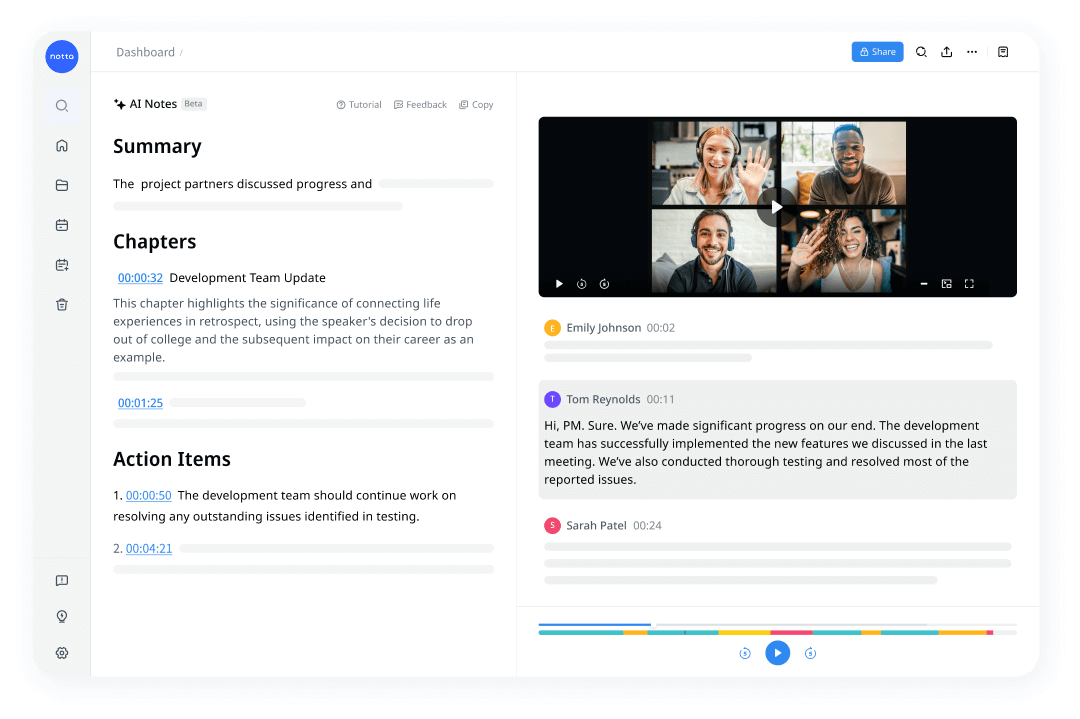
7 Pro Tips to Run Effective Virtual One-on-one Meetings
98% accurate, real-time transcription in just a few clicks. 58 languages and multiple platforms supported.
Remote and hybrid work have come to stay, and every forward-thinking organization is at peace with this reality. However, many managers still struggle to manage a distributed workforce because team members can easily become isolated and disconnected from their productive selves. That's where virtual one-on-one meetings come in.
A virtual one-on-one meeting provides a space for managers to offer individualized feedback and guidance to their team members. These meetings are especially important because of their more personal and private setting.
But how can managers get the most out of their one-on-one virtual meetings? How are these meetings different from the physical ones? These and more are what you'll learn in this piece.
In-person vs. virtual one-on-one: what’s the difference?
On the surface, the difference between an in-person and virtual meeting is that the former allows for face-to-face communication, while the latter is typically held online via a video conferencing platform.
However, there are other areas of separation between the two. Let’s take some.
Nonverbal cues
In-person meetings typically allow for nonverbal communication, such as body language and facial expression, which can enhance the communication process. In remote meetings, however, there are limitations to the ability to communicate nonverbally.
Referencing and documentation
Virtual meetings can be more easily recorded or transcribed, which can be useful for documentation or follow-up purposes. Documentation of in-person meetings is time-consuming and difficult.
Personal connection
In-person meetings may provide a more immersive and engaging personal connection between a manager and the employee as they can talk face-to-face. While remote one-on-one meetings may lack some of the personal touch needed to build quick rapport.
Why do one-on-one meetings matter for remote teams?
While the approach to one-on-one meetings may differ from organization to organization, the goal remains the same: to facilitate a growth-driving employee-manager relationship.
In a remote and hybrid work setting, one-on-one meetings are more important than ever. Here are some reasons:
Enhance remote team productivity
While managing a remote team, providing real-time feedback and support can be more difficult. By making the time to have virtual one-on-one meetings, remote managers stay informed about the happenings within their team and identify any potential issues that need to be addressed. Thereby, improving team communication, cohesiveness, and overall productivity.
Regular and individualized feedback
Your annual or biannual performance review can be too late to address some issues. Regular one-on-one meetings, whether weekly or biweekly, allow managers to comment on employee performance on time and in private.
Criticizing direct reports in public or in the presence of other team members is never a good managerial practice. Besides being embarrassing, it might lower their morale, which can affect the team's overall performance.
Psychological safety
Perhaps the most significant benefit of one-on-one meetings for remote teams. To make employees divulge their most covered struggles, you need to create an ambiance that guarantees safety.
A one-on-one meeting is the perfect place to ask about the challenges facing team members. With the privacy of a one-on-one meeting, they’d be free to share their situation without fear of judgment.
7 tips to run one-on-one meetings with remote employees
Compared to large meetings, one-on-ones provide a private setting for employees to share their thoughts, feel heard, and be respected, which translates to loyalty and prudent discharge of responsibility, which are at the core of any productive workforce.
Below are seven tips to make your virtual one-on-one meeting with a remote employee more rewarding.
1. Prepare right for remote meetings
Preparing for your meeting means taking care of anything that can turn your meeting into a tussle, maybe with your gadget or your environment.
Make sure your internet connection is stable. A poor internet connection can cause your video to be choppy and laggy, which can puncture your conversation flow.
Test your video and audio before the meeting to ensure everything is working as expected. If you think your device's camera and microphone need improvement, make a one-time investment in a high-quality webcam and microphone.
Set aside a quiet and distraction-free space for the meeting. If you WFH, put a ‘Do Not Disturb’ note on the door to notify others.
Choose a plain and clean background. Consider using virtual backgrounds or a green screen to improve the on-camera appearance.
2. Dress professionally
Being in a virtual meeting doesn’t mean you should hop in with your pajamas on or finger-combed hair. The right dress for a virtual meeting is not written in stone. But a good rule of thumb is to dress as you would for an in-person meeting.
Avoid clothes with loud patterns and overly bright colors, as they can be distracting on screen. Instead, opt for solid colors and clean lines, which are more professional and polished.
When dressing for a virtual meeting, it's important to consider the impression you want to make. Make sure your clothing fits well and is not revealing.
3. Share a meeting agenda
A meeting agenda is a document that outlines the topics and discourse of a meeting. Having one for your virtual one-on-one meeting is necessary for good reasons.
First, sharing a meeting agenda makes participants gather relevant materials or documents beforehand. This will help them understand the context and background of the discussion and open the door for informed questions and answers.
On top of that, employees will feel more confident and engaged in the conversation, which makes your meeting more effective.
Pro Tip: Apply the one-on-one meeting templates created by the professional instead of starting from scratch. You can directly use it or make adjustments based on your needs.
4. Make the meeting employee-centric
In a one-on-one meeting, the manager should spend most of the time listening while the employee does the talking. Remember, it’s an avenue to discuss team members' performance and growth, individually and within their team. And it's best approached as such.
One-on-ones are more productive when the manager is attentive, supportive, and open to employee ideas and concerns. By lending a listening ear to employee struggles, managers quickly identify areas of concern and tackle them in earnest.
Employee-focused meetings foster a sense of trust and respect between team members and leadership. As the employees feel valued, supported, and invested in, they’d be ready to give their all for the success of the team and the organization as a whole.
5. Ask the right questions
The key to a successful one-on-one meeting is asking the right questions. In fact, it’s safe to say a one-on-one meeting is a Q&A session where the manager asks focused questions about the employee's personal and professional life.
The right questions are what drive a productive and meaningful one-on-one conversation. Here are some one-on-one questions you can ask to get the most out of your meeting:
What have been your biggest challenges or obstacles in your work recently?
Do you feel comfortable and productive working from home?
What do you think your Work from home setup lacks?
What can we do as a team to make remote collaboration easier?
What do you think are the most important goals or objectives for your work right now?
How are you doing in terms of meeting those goals or objectives?
Are there any areas where you could use additional support or resources?
How can the company help you achieve your career goal?
6. Keep and share meeting minutes
Keeping meeting minutes is a standard practice in both in-person and virtual meetings. A good minute captures important information and key decisions made during the meeting. They are essential for follow-ups on action items and progress tracking.
After the meeting, review your notes and make any necessary updates or clarifications. You can also use your notes to help you prepare any reports or summaries that may be required and share them with the team members.
Pro Tip: Don’t want to split your attention to taking notes? The Notta meeting assistant will record and transcribe your online meetings automatically, so you can stay engaged in the conversation and never miss any details.

7. Keep track of action items
Action items are useless if you don’t keep them on track. Before moving into the talking points of each remote one-on-one meeting, you may revisit previous action items assigned to the direct report.
Tracking action items makes sure they can be completed on time and gives helpful guidance when employees face difficulties.
Notta offers the most integrated AI meeting notes, summaries, and action items so nothing gets missed.
Good check-in questions for virtual one-on-one meetings
If you really want to keep a pulse on your team members, check-in questions are the fastest way to get there.
The secret behind check-in questions is that they build emotional connections with team members and ease them into the conversation. Let’s look at some good check-in questions for virtual one-on-one meetings.
How are you feeling today? Is there anything on your mind that you'd like to discuss?
How was your weekend? Hope you had a nice family time with your wife and kids.
If money wasn’t an object, what’s your plan for a dream vacation?
What helps you unwind and de-stress
What’s that movie you can get tired of watching?
What’s the best thing you’ve acquired so far this year?
What was the most unique fashion trend you ever embraced?
What is your favorite part of working from home?
Are you productive in the morning or at night?
What is your favorite holiday?
What’s the best piece of advice you’ve ever gotten from a friend/colleague?
What’s your favorite TV show?
Do you know how to speak more than one language?
What was the worst job you’ve ever had?
How would you describe your job to a five-year-old?
What is your hobby?
What do your family and friends think you do all day?
If you had to move to another country, which one would you choose?
Have you ever won something as a member of a team?
What do people not understand about you?
Succeed at your virtual one-on-one
Running a virtual one-on-one meeting within a remote team can be difficult. But it doesn’t have to be. With the 7 tips above and a meeting notetaker tool like Notta, your next virtual one-on-one will come to fruition.
Lastly, the purpose of one-on-ones is to foster a sense of trust, allowing team members to connect with their manager and feel supported in their work, growth, and career. Always make it about them and them alone.